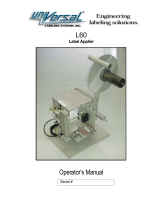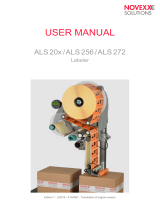
18 19
6 Error Messages
6.1 Error Messages of the Printer
For detailed information about printer errors (e.g. 'Paper out', 'Ribbon out', etc.) Check the operator's manual of the
printer.
Error treatment:
Clearing the error results.
Press the feed
key to synchronize the label feed, remove the left over labels manually.
Press the pause key to quit the error state.
After error correction, the label causing the error will be reprinted.
Continue Afterrecticationofthecauseoftheerrortheprintjobcommenceswiththenextlabelofthe
printing job.
Repeat Afterrecticationofthecauseoftheerrortheprintjobcommenceswiththelastlabelofthe
printing job.
Cancel The current print job will be canceled.
6.2 Error Messages of the Applicator
Thefollowingtablecontainsanoverviewofapplicatorspecicerrormessagesandtheirpossiblecauses.Italso
suggests methods to resolve the error states:
Error Message Possible Cause Possible Solution
Air pressure ins. Compressed air is switched off Check the compressed air switch.
Label not depos. Label has not been placed onto the product;
while the pad is moving back the label is still
sticking to the pad.
Manually label the product.
Upper position Pad is not in the starting position when the
printer was switched on; Pad has not reached
the labelling position within 2 s after the
movement of the pad was started; pad has left
the printing position without authorization.
Checktheairpressureconguration(particu-
larly the upper throttle valve).
Manually label the product.
Ext. I/O error Labeling process was interrupted by the PLC
interface with a STOP signal.
If necessary label the product by hand.
Sensor error The sensor for the labeling position was not
triggered from the start of the labeling process
until reaching the labeling position.
Check the sensor (Service).
Vac. plate empty Label has not been picked up properly by the
pad; label fell off the pad before it could be
placed onto the product.
If possible place the "lost" label onto the
product manually.
Otherwise cancel the print job and restart it
with edited parameters (e.g. Numbers).
If this error is repeated check the alignment
of the pad as well as settings for vacuum and
supporting air as well as peel-off offsets.
Lower position Pad has not reached the starting position
within 2 s after the pad has left the labelling
position; or pad has left the starting position
without authorization.
Check the compressed air settings (especially
the bottom throttle valve).
Verify that the mechanics of the applicator are
in order.
Ensure the impact sensor is working correctly.
Label the product by hand.
Table 5 Error messages of the applicator





















